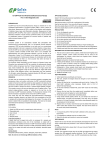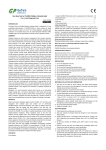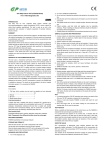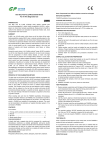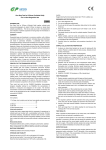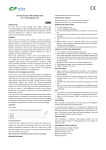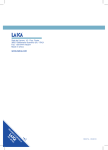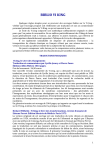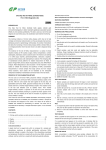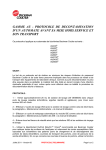Download One Step Test for hs-CRP (Colloidal Gold
Transcript
One Step Test for hs-CRP (Colloidal Gold) For In Vitro Diagnostic Use Manual INTENDED USE One Step Test for hs-CRP (Colloidal Gold) applies colloidal gold immunochromatography to detect C-reactive protein (CRP) in serum, plasma or whole blood samples quantitatively. Measurement of CRP is useful for the detection and evaluation of infection, tissue injury and inflammatory disorders. Measurements high sensitivity CRP (hs-CPR), when used in conjunction with traditional clinical laboratory evaluation of acute coronary syndromes, may be useful as an independent marker of prognosis for recurrent events, in patients with stable coronary disease or acute coronary syndromes. SUMMARY C-reactive protein is an acute-phase reactant that precipitated with Pneumococcal C-polysaccharide, and is a non-specific immune response component. CRP has wide distribution in our body, and is an acute-phase protein produced in the liver in response to microbic infection or tissue injury, and the hs-CRP can be detected in serum or plasma at lower concentrations by more sensitive method. Studies revealed hs-CRP levels seem to be correlated with atherosclerosis and Acute Myocardial Infarction. And the hs-CRP is an inflammation "marker" for ACS patient and is helpful for primary prevention and risk assessment of cardiovascular disease. Its combination with the ratio of total cholesterol to HDL-C is more accurate than other risk factor in predicting cardiovascular disease. The American Heart Association and US Centers for Disease Control and Prevention have advocated hs-CRP as a predictor of cardiovascular disease (CVD) to define risk groups: less than 1.0mg/L indicates low risk, 1.0 to 3.0 mg/L means moderate risk, and the amount above 3.0 mg/L (lower than 10mg/L) strongly suggests a high risk of CVD. Moreover, higher CRP levels are found in late pregnant women, mild inflammation and viral infections (10–40 mg/L), active inflammation, bacterial infection (40–200 mg/L), severe bacterial infections and burns (>200 mg/L). PRINCIPLE OF THE EXAMINATION METHOD The test uses a monoclonal anti-human hs-CRP antibody conjugated with colloidal gold and another monoclonal anti-human hs-CRP antibody coated on the test line. After the sample (serum, plasma or whole blood) has been applied to the test strip, the gold-labelled monoclonal anti-human hs-CRP antibody binds to the hs-CRP in sample and forms a marked antigen-antibody complex. This complex moves to the test card detection zone by capillary action. Then marked antigen- antibody complex is captured on the test line by the monoclonal anti-human hs-CRP antibody resulting in a purplish red streak appears on the test line. The color intensity of the test line increases in proportion to the amout of hs-CRP in sample. Then insert test card into the FIA8000 Quantitative Immunoassay Analyzer (hereafter referred to as FIA8000), the concentration of hs-CRP is measured and displayed on the screen. The hs-CRP concentration is stored in the FIA8000 and is available on demand. The result can be transmitted to the lab or hospital information system, if it is connected to FIA8000. CONTENTS A kit contains: 1. Foil bag, which contains one test card, one pipette and one desiccant ···························································· 25 2. Manual ················································· 1 3. SD card ··············································· 1 4. Blood sample diluent ······························· 25 A test card consists of: A plastic shell and a reagent strip which is composed of a sample pad, a colloidal gold pad (coated with a gold-labelled anti-human hs-CRP monoclonal antibody), nitrocellulose membrane (the test line is coated with another anti-human hs-CRP monoclonal antibody, and the control line is coated with rabbit anti-mouse IgG antibody), absorbent paper and liner. Blood sample diluent: Phosphate buffered saline, proteins, detergent, preservative, stabilizer. Note: Components from different batches cannot be exchanged. MATCHING EQUIPMENT FIA8000 Quantitative Immunoassay Analyzer STORAGE AND STABILITY Store the test card at 4~30oC with a valid period of 24 months. Use the test card within 1 hour once the foil bag is opened. o Store the blood sample diluent at 0~30 C with a valid period of 24 months. Suggest storing the blood sample diluent at 2~8oC for a better use. WARNINGS AND PRECAUTIONS 1. For In-Vitro diagnostic use. 2. For use by healthcare professionals. 3. Do not use the kit beyond the expiration date printed on the outside of the box. 4. Keep the test card in the sealed pouch until ready to use. Do not reuse the used cards. 5. The pipette should not be used for multiple samples. Discard it after single use. 6. Patient samples, used test cards and pipettes may be potentially infectious. Proper handling and disposal methods should be followed in accordance with local regulations. 7. Carefully follow the instructions and procedures described in this manual. SAMPLE COLLECTION AND PREPARATION 1. A serum, plasma or whole blood sample can be used for testing with this product. Samples should be free of hemolysis. 2. Heparin/EDTA needs to be used as anticoagulant. 3. If testing cannot be completed immediately, the serum and plasma sample should be stored up to 7 days at 2~8oC or stored at -20oC for 6 months (whole blood sample should be stored up to 3 days at 2~8oC) until it can be tested. 4. Samples must be recovered to room temperature before testing. Frozen samples are required to be completely thawed and mixed thoroughly prior to testing. Minimize repeat freeze-thaw cycles to less than 3 times for tested samples to acquire accurate data. 5. Avoid heating the samples, which can cause hemolysis and protein denaturation. 6. SAMPLE VOLUME: 10 μl serum, plasma or 20μl whole blood. TEST PROCEDURE 1. Restore samples, sealed test-card foil bags and blood sample diluent to room temperature before using. Open the foil bag, label cards with numbers and use the test cards immediately. 2. Confirm SD card lot No. in accord with test kit lot No.. Perform “QC SD” operation (Details refer to 8.3.1 of FIA8000 User’s Manual) when necessary. 3. Add 10 μl plasma or serum or 20 μl whole blood to one tube of blood sample diluent, and mix gently and thoroughly. Drop 120 μl of sample mixture to the sample port on test card. Wait for 7 minutes, insert the card immediately into FIA8000 and press "OK" button, the test card can be detected and the result will be printed automatically. Note: 1. It is required to perform “QC SD” operation when using a new batch of kits; Only one “QC SD” operation is required for the same batch. 2. Assure of card side towards FIA8000 is correct and insert the card completely. 3. Don’t wait longer than 30 min before reading the card because the readings after 30 min won’t be accurate. TEST RESULTS When a purplish-red band appears in the control area, use the FIA8000 to analyse the test card and get a quantitative result. If no purplish-red band appears in the control area, it indicates that the operation is incorrect or the test card has passed its expiration date. In this case, please read the manual again carefully and use a new test card to try again, if the problem persists, please stop using all products of the same batch immediately and contact with your supplier. EXPECTED VALUE hs-CRP: hs-CRP concentration is determined using samples obtained th from 500 apparently healthy individuals. The 95 percentile of the concentration for hs-CRP is 3 mg/L. If the concentration of hs-CRP is less than 3 mg/L, it can be estimated as normal. DESCRIPTION OF SYMBOLS USED The following are graphical symbols used in or found on One Step Test for hs-CRP (Colloidal Gold) are the most common ones appearing on medical devices and their packaging. They are explained in more detail in the European Standard EN 980: 2008 and International Standard ISO 15223-1:2007. Key to symbols used CRP: CRP concentration is determined using samples obtained from th 500 apparently healthy individuals. The 95 percentile of the concentration for CRP is 10 mg/L. If the concentration of CRP is less than 10 mg/L, it can be estimated as normal. If the concentration is higher than 10 mg/L, it can be estimated as inflammation or infection. Manufacturer Expiration Date PERFORMANCE CHARACTERISTICS Do not re-use Date of manufacture Measuring Range: 0.5~200 mg/L Lower Detection Limit: ≤0.5 mg/L Within-Run Precision (n=10): ≤10% Between-Run Precision: ≤15% Recovery: CRP: 101% (mean) hs-CRP: 103% (mean) Method Comparison: The assay was compared to HITACHI7600/OLYMPUS-AU5400 and the matching hs-CRP test kits with 200 patient serum samples (61 positive samples, 139 negative samples). The correlation coefficient (r) is 0.941. Consult instructions Batch code for use Temperature In vitro diagnostic limitation medical device Authorized Sufficient for European Community LIMITATIONS OF THE PROCEDURE 1. The result of the test should be evaluated in the context of all the clinical and laboratory data available. In those instances where the laboratory results do not agree with the clinical evaluation, additional tests should be performed accordingly. 2. Some substances in blood samples as listed below may interfere with the test and cause erroneous results. The maximum allowance concentration of them is as follows: Interfering Substance representative in the Concentration (Max) Hemoglobin 5 g/L Triglyceride 10 g/L Bilirubin 0.2 g/L REFERENCES 1. Danesh J, Whincup P, Wslker M, et al. Low grade inflammation and coronary heart disease: prospective study and updated neta-analyses. BJM 2000; 321: 199~204. 2. Rifai N, Ridker PM. Proposed cardiovascular risk assessment algorithm using high-sensitivity C-reactive protein and lipid screening. Clin Chem 2001; 47: 28~30. 3.EN ISO 18113-1:2009 In vitro diagnostic medical devices - Information supplied by the manufacturer (labelling) - Part 1: Terms, definitions and general requirements. 4.EN ISO 18113-2:2009 In vitro diagnostic medical devices - Information supplied by the manufacturer (labelling) - Part 2: In vitro diagnostic reagents for professional use (ISO 18113-2:2009). CE marking Thank you for purchasing One Step Test for hs-CRP (Colloidal Gold). Please read this manual carefully before operating to ensure proper use. Version:131210


